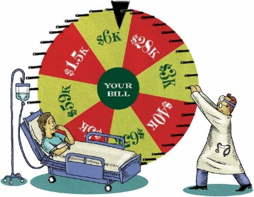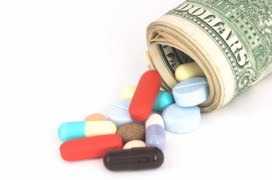- Provide true price transparency for in-patient hospital care
 Price transparency initiatives are being pushed from the federal government, state governments, employers,
Price transparency initiatives are being pushed from the federal government, state governments, employers,
consumers, and other stakeholders.1 Consumers, whether they be individuals, corporations or insurers want to understand the costs of inpatient and outpatient care in order to make better and more informed purchasing decisions. “The Center for Medicare and Medicaid Services (“CMS”) took steps in the fiscal year (“FY”) 2015 Inpatient Prospective Payment System (“IPPS”) final rule to implement the Affordable Care Act’s (“ACA”) provision requiring hospitals to establish and make public a list of its standard charges for items and services. In the final rule, CMS reminded hospitals of this requirement and reiterated that they encourage providers to move beyond just the required charge transparency and assist consumers in understanding their ultimate financial responsibility.”2
- Improve the prescription process
Many Americans have a medical condition that requires routine medication every day. As an example drugs to reduce high cholesterol or blood pressure. These conditions require a prescription to be refilled with some regularity i.e. every month or 90 days. The system should make it easy for these patient to obtain the refill order, place the order with the pharmacy, get a text or E-mail that the prescription is ready for pick-up (unless its mailed to their home) and the out-of-pocket costs electronically. Right now the process is cumbersome for many because of the payer, physician and pharmacy interfaces and it should be seamless with technology.
- Provide hospital ED pricing before delivery of non-emergency care
 Many patients that go to a hospital’s Emergency Department for care are shocked when they receive their bill. The hospitals bill alone is enough to cause heart failure but if the ED physician is part of an out-sourced service then they invoice separately and their professional fee is often astronomical and well beyond what most consumers would find reasonable and prudent. Fees should be posted and/or available for most conditions along with alternative forms of care for non -emergency conditions i.e. treatment of colds, aches, pains etc.
Many patients that go to a hospital’s Emergency Department for care are shocked when they receive their bill. The hospitals bill alone is enough to cause heart failure but if the ED physician is part of an out-sourced service then they invoice separately and their professional fee is often astronomical and well beyond what most consumers would find reasonable and prudent. Fees should be posted and/or available for most conditions along with alternative forms of care for non -emergency conditions i.e. treatment of colds, aches, pains etc.
- Incorporate an electronic chart that follows you.
Enough with the redundancy of paperwork and tests. In most cases if a patient is referred to a specialist whether a physician or a dentist the patient needs to complete once again all of their history and payment information and then succumb to having the same tests (laboratory and/or x-rays) taken again. This is where fee-for-service has gone astray. An electronic chart with the current patient information should follow each patient to eliminate redundant paperwork and tests. It will save time and billions of dollars Within healthcare networks we are getting closer to making this a reality but it needs to be available for everyone and the sooner the better.
- Provide reviews of hospitals, physicians, surgeons and dentists that are meaningful, fair and accurate.
 There is no shortage of websites that are emerging that review hospital ratings, infection rates, how to select a surgeon, physician and dentist reviews and surgeon complication rates. How do consumers know who to believe? Is it CMS? Propublica.org? Consumer Reports? Healthgrades? or someone else? Consumers need one reliable website where they can find unbiased information on reviews of hospitals, physicians, surgeons and dentists that are meaningful, fair and accurate.
There is no shortage of websites that are emerging that review hospital ratings, infection rates, how to select a surgeon, physician and dentist reviews and surgeon complication rates. How do consumers know who to believe? Is it CMS? Propublica.org? Consumer Reports? Healthgrades? or someone else? Consumers need one reliable website where they can find unbiased information on reviews of hospitals, physicians, surgeons and dentists that are meaningful, fair and accurate.
- Provide adequate funding for mental illness treatment
Only 41% of adults in the U.S. with a mental health condition received mental health services in the past year. Among adults with a serious mental illness, 62.9% received mental health services in the past year.3 Serious mental illness costs America $193.2 billion in lost earnings per year.4 States across the country cut mental health funding during the recession by approximately $4 billion. Nationwide there were 43,318 psychiatric beds in 2010 compared with 50,509 in 2005.5 On January 5th the President added $500 million back into the budget. It’s not enough. Mental health diagnosis and treatment needs to be funded properly.
- Leave critical care hospitals alone
 Everyone that lives in rural areas needs access to local, quality and compassionate care. The federal government needs to preserve critical care access hospital reimbursement and supplant it with virtual care and telemedicine. In 2015 U.S. Agriculture Secretary, Tom Vilsack, expanded the USDA Rural Development’s Distance Learning and Telemedicine Program with $23.4 million in additional funding for 75 new projects in 31 states. The grants may be used to purchase telemedicine educational tools, equipment and services in rural areas and are contingent upon each recipient meeting the grant agreement terms. More of this type of funding is required. Let’s stop the closure of critical care access hospitals. They are vital community assets.
Everyone that lives in rural areas needs access to local, quality and compassionate care. The federal government needs to preserve critical care access hospital reimbursement and supplant it with virtual care and telemedicine. In 2015 U.S. Agriculture Secretary, Tom Vilsack, expanded the USDA Rural Development’s Distance Learning and Telemedicine Program with $23.4 million in additional funding for 75 new projects in 31 states. The grants may be used to purchase telemedicine educational tools, equipment and services in rural areas and are contingent upon each recipient meeting the grant agreement terms. More of this type of funding is required. Let’s stop the closure of critical care access hospitals. They are vital community assets.
- Provide healthy foods in hospital cafeterias and vending machines.
Unfortunately, many USA hospitals still serve sugary sodas, candy bars, junk food and fried foods. Many offer a fast food restaurant on their campus that serves a plethora of unhealthy choices. These should be removed and instead every hospital should provide healthy food choices for their patients, staff members and family members. Since hospitals employ dieticians and control all of the food services provided there is no excuse for providing and promoting unhealthy food. Furthermore, each food item should show the calorie count so that healthy choices can be made more easily. Hospitals should pave the way to embody healthy eating to help everyone avoid chronic disease.
- Curtail prescription drug prices
 In 2015 drug prices increased 12.2% which was far ahead of the consumer price index. With the rise of high deductible healthcare plans consumers are feeling the pain of these high prices that seem to grow unabated. Several recent polls have suggested drug prices are now the general public’s No.1 healthcare concern.6 Biosimilars which are products used in medicine that are generated from living organisms will provide some relief to biologic specialty drug costs but more help is required. A 2014 RAND study projects that biosimilar drugs could result in more than $44 billion in savings on biologic drugs between 2014 and 2024.7
In 2015 drug prices increased 12.2% which was far ahead of the consumer price index. With the rise of high deductible healthcare plans consumers are feeling the pain of these high prices that seem to grow unabated. Several recent polls have suggested drug prices are now the general public’s No.1 healthcare concern.6 Biosimilars which are products used in medicine that are generated from living organisms will provide some relief to biologic specialty drug costs but more help is required. A 2014 RAND study projects that biosimilar drugs could result in more than $44 billion in savings on biologic drugs between 2014 and 2024.7
Parting Thoughts
These are our thoughts on several ways that healthcare could be improved in 2016. What are yours?
- Smith M. The Push for Hospital Price Transparency: How is Your Organization Responding? The Camden Group, June 2, 2015
- The National Conference of State Legislatures, 2015
- Substance Abuse and Mental Health Services Administration, Results from the 2014 National Survey on Drug Use and Health: Mental Health Findings, NSDUH Series H-50, HHS Publication No. (SMA) 15-4927. Rockville, MD: Substance Abuse and Mental Health Services Administration. (2015). Retrieved October 27, 2015 from http://www.samhsa.gov/data/sites/default/files/NSDUH-FRR1-2014/NSDUH-FRR1-2014.pdf
- Insel, T.R. (2008). Assessing the Economic Costs of Serious Mental Illness. The American Journal of Psychiatry. 165(6), 663-665.
- Johnson SR: Ruling could spur action to address psychiatric boarding crisis. Modern Healthcare September 1, 2014
- Cryts A. Reimbursement hurdles associated with biosimilars. Managed Health Executive January 1. 2016
- Johnson SR: Healthcare leaders back feds stepping in to restrain drug prices. Modern Healthcare November 16, 2015
As always we welcome your thoughts and input. Let’s start a discussion and elevate the sales profession with a thoughtful, civil and informative discourse.


